|
Sunday:
August 1, 2004 | |
0121 GMT |
 |
MESSENGER counting down to overnight blastoff
The MESSENGER spacecraft's departure for its seven-year voyage to Mercury remains scheduled for blastoff at 2:16 a.m. EDT (0616 GMT) Monday aboard a Boeing Delta 2 rocket from Cape Canaveral, Florida.
 MISSION STATUS CENTER - live updates! MISSION STATUS CENTER - live updates!
 OUR PREVIEW STORY OUR PREVIEW STORY
 LAUNCH EVENTS TIMELINE LAUNCH EVENTS TIMELINE
 GROUND TRACK MAP GROUND TRACK MAP
 |  |
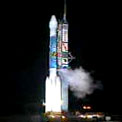
|
 |

Additional coverage for subscribers:
 VIDEO:
WATCH THE MESSENGER MISSION NEWS CONFERENCE QT VIDEO:
WATCH THE MESSENGER MISSION NEWS CONFERENCE QT
 SUBSCRIBE NOW SUBSCRIBE NOW

|
Catching a falling star
While observing a supernova in a distant galaxy with the Very Large Telescope at Paranal Observatory, astronomers were incredibly lucky to obtain serendipitously a high quality spectrum of a very large meteor in the terrestrial atmosphere.
 FULL STORY FULL STORY
 |  |

|
 |
OTHER HEADLINES Additional stories today
|
 |
Space station status update -- Expedition 9 Commander Gennady Padalka and Flight Engineer Mike Fincke this week marked their 100th day in orbit, oversaw the undocking of a resupply craft and prepared for their third spacewalk.

NASA releases Broad Agency Announcement -- NASA's Office of Exploration Systems has released a Broad Agency Announcement for Human and Robotic Technology system-of-systems that will seek research and technology development proposals in support of the nation's Vision for Space Exploration.
|
 |
|
Saturday:
July 31, 2004 | |
0633 GMT |
 |
Titan's purple covering points to a fuzzy past
Encircled in purple stratospheric haze, Saturn's largest moon, Titan, appears as a softly glowing sphere in this colorized image taken on July 3, one day after Cassini's first flyby of that moon. Titan has a dense atmosphere composed primarily of nitrogen with a few percent methane. The atmosphere can undergo photochemical processes to form hazes.
 FULL STORY FULL STORY
 |  |
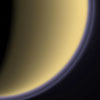
|
 |
Neutrinos linked to 'dark energy'
Two of the biggest physics breakthroughs during the last decade are the discovery that wispy subatomic particles called neutrinos actually have a small amount of mass and the detection that the expansion of the universe is actually picking up speed.
 FULL STORY FULL STORY
 |  |

|
 |
|
Friday:
July 30, 2004 | |
0121 GMT |
 |
NASA looks to new astronomy mission ideas
NASA has selected nine studies to investigate new ideas for future mission concepts within its Astronomical Search for Origins Program. Among the new missions are some that will survey one
billion stars within our own galaxy, measure the distribution of galaxies in the distant universe, study dust and gas between galaxies, study organic compounds in space and investigate their role in planetary system formation and create an optical-ultraviolet telescope to replace the Hubble Space Telescope.
 FULL STORY FULL STORY
 |  |

|
 |
Swift to catch mysterious bursts from deep in cosmos
The Swift satellite, which will pinpoint the location of distant yet fleeting explosions that appear to signal the births of black holes, arrived at Kennedy Space Center Thursday in preparation for an October launch.
 FULL STORY FULL STORY
 |  |

|
 |
OTHER HEADLINES Additional stories today
|
 |
Boeing names chief engineer for NASA Systems -- Joy Bryant has been selected as the chief engineer for Boeing's NASA Systems business unit. In her new position, Bryant will leverage her experience and expertise in expendable launch systems to further launch the Vision for Space Exploration.
|
 |
|
Thursday:
July 29, 2004 | |
0458 GMT |
 |
Hazy all over Titan
Following its first flyby of Titan, Cassini gazed back at the smog-enshrouded moon's receding crescent. This natural color view was seen by the spacecraft about one day after closest approach. The slight bluish glow of Titan's haze is visible along the limb.
 FULL STORY FULL STORY
 |  |
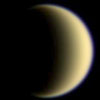
|
 |
Mysterious plasma jets on the Sun explained
Solar physicists from Lockheed Martin and the Solar Physics and upper-Atmosphere Research Group at the Department of Applied Mathematics of the University of Sheffield, UK have used computer modeling and some of the highest resolution images ever taken of the solar atmosphere to explain the cause of supersonic jets that continuously shoot through the low atmosphere of the Sun.
 FULL STORY FULL STORY
 |  |

|
 |
Stellar pair shot out from supernova birthplace
Astronomers studying data from the National Science Foundation's Very Long Baseline Array and other telescopes have concluded that a binary pair of stars forming an energetic microquasar was blasted out of the cluster in which it was born by a supernova explosion some 1.7 million years ago. This is the first time that a fast-moving stellar pair has been tracked back to a specific star cluster.
 FULL STORY FULL STORY
 |  |

|
 |
|
Wednesday:
July 28, 2004 | |
0158 GMT |
 |
X Prize competitors announce flight plans
The $10-million Ansari X Prize took on a David vs. Goliath flavor on Tuesday, as one well-funded team announced plans to fly its vehicle in late September in a bid for the prize while an upstart Canadian competitor reasserted its plans to go after the prize this fall as well.
 FULL STORY FULL STORY
 X PRIZE NEWS RELEASE X PRIZE NEWS RELEASE
 |  |

|
 |
Cassini's rear-view image of Saturn's moon Titan
A day after entering orbit around Saturn, Cassini sped silently past Titan, imaging the moon's south polar region. This natural color image represents Cassini's view only about two hours after closest approach to the moon.
 FULL STORY FULL STORY
 |  |
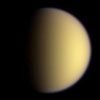
|
 |
Boeing submits design proposal for Jupiter probe
Boeing has delivered its conceptual design proposal for the Jupiter Icy Moons Orbiter (JIMO), a spacecraft that could become the nation's first nuclear-fission-powered exploration vehicle with technologies applicable to future Mars and lunar missions.
 FULL STORY FULL STORY
 |  |

|
 |
Largest environmental experiment in history on tap
Researchers from around the globe participating in the world's largest environmental science experiment, the Large-Scale Biosphere Atmosphere Experiment in Amazonia, will, fittingly, convene in Brazil this week.
 FULL STORY FULL STORY
 |  |

|
 |
|
Tuesday:
July 27, 2004 | |
0257 GMT |
 |
NASA approves new design for shuttle tank bipod
NASA is moving ahead with plans to redesign a part of the space shuttle external fuel tank that investigators believe played a critical role in the Columbia accident. The shuttle program will soon begin manufacturing and installing an improved bipod fitting, which connects the external fuel tank to the shuttle during launch.
 FULL STORY FULL STORY
 |  |

|
 |
Odd-looking moon Mimas photographed by Cassini
Soon after orbital insertion, Cassini returned its best look yet at heavily cratered Mimas. The enormous crater at the top of this image, named Herschel, is about 80 miles wide and 6 miles deep.
 FULL STORY FULL STORY
 |  |
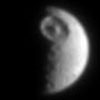
|
 |
Ship-sinking monster waves revealed by satellites
Once dismissed as a nautical myth, freakish ocean waves that rise as tall as ten-story apartment blocks have been accepted as a leading cause of large ship sinkings. Results from the European Space Agency's ERS satellites helped establish the widespread existence of these 'rogue' waves and are now being used to study their origins.
 FULL STORY FULL STORY
 |  |

|
 |
OTHER HEADLINES Additional stories today
|
 |
NASA helps bring space and science to blind students -- NASA is making available its resources and facilities as part of a program to provide the first-ever science camp for blind middle- and high-school students from all over the United States.
|
 |
|
Monday:
July 26, 2004 | |
0325 GMT |
 |
Challenger crew honored with Space Medal of Honor
The families of the Space Shuttle Challenger's crew has accepted the Congressional Space Medal of Honor from NASA Administrator Sean O'Keefe. The honors, presented in the name of Congress and on behalf of President George W. Bush, were made during a private ceremony with the families of the seven astronauts in Washington.
 FULL STORY FULL STORY
 |  |

|
 |
China launches second Double Star satellite
The second of two joint Chinese-European science satellites was launched Sunday to probe the complicated relationship between Earth and our Sun. A Long March 2C rocket carried the Double Star 2 craft into orbit.
 FULL STORY FULL STORY
 COVERAGE OF FIRST DOUBLE STAR LAUNCH COVERAGE OF FIRST DOUBLE STAR LAUNCH
 |  |

|
 |



